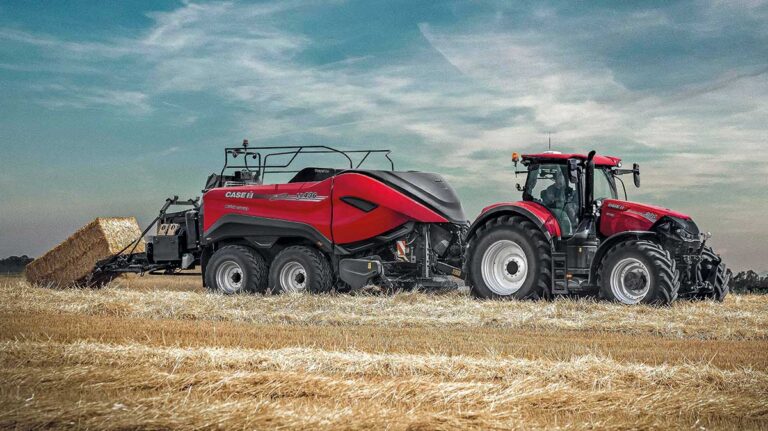A large square baler offers near non-stop operation, when everything is going well. It makes sense then that they really come into their own during harvest, when straw baling can be a necessary annoyance that holds up the grower between combining and crop establishment.
There are other notable benefits in straw as well. The high density provided by even base-level machines – saying nothing about the power-hungry, high-density units – make it possible to consolidate large swathes of straw into a manageable number of bales, reducing the storage space needed and making the most economical use of lorries if straw is being exported.
Updates to the large square baler have been primarily focused on software for this season.
This looks like telematics to note the position and moisture of bales to make life easier for the following worker having to stack them; it also looks like greater levels of automation.
The large square baler is already nearly fully automatic, but clever technology to pre-empt the windrow and adjust both the baler and the tractor without operator input can boost productivity in the field.
Case IH
The Case IH LB 436 HD large square baler received some important upgrades for 2024, centred around a new load-sensing hydraulic system.
This allows operations typically activated from the rear of the baler to be controlled from the cab via the baler monitor or tractor Isobus terminal. It includes full or partial bale ejection and opening or closing of the bale chute.
Tandem axle steering can also be locked from the terminal, with the rear steering axle locking automatically when reversing or when in road mode.
For maximum flexibility with different tractor and hydraulic coupler types, flat face hose connectors can now be specified in place of the standard conical types.
Internally, durability enhancements include improved plunger rollers with sealed bearings or heavy-duty units with greaseable bearings, stronger stuffer brake springs, a stronger rotor drive chain, an optional Hardox 400 packer feeder bottom plate, and a more easily accessed pick-up greasing point.
There is also a reinforced crop-holding finger shaft, improved optional hydraulic jack with double-acting safety valve, and additional guides on the front-end hinges of the bale chute to enhance strength.
User interface improvements include a swath feed left/right indicator to aid steering for even feeding, bale length calibration, an offset setting for the moisture sensor, and a new bale automation menu for setting automatic speed control and steering.
Further automation is now available for Case IH large square balers. This is achieved via a Lidar sensor mounted on the cab, which emits laser pulses to the area in front of the tractor which are then reflected by the surface of the field and the swath.
The system calculates the position and shape of the swath, sending information to the Isobus system to adjust steering. The sensor also measures tractor speed and adjusts the speed to prevent overloads or maximise productivity.
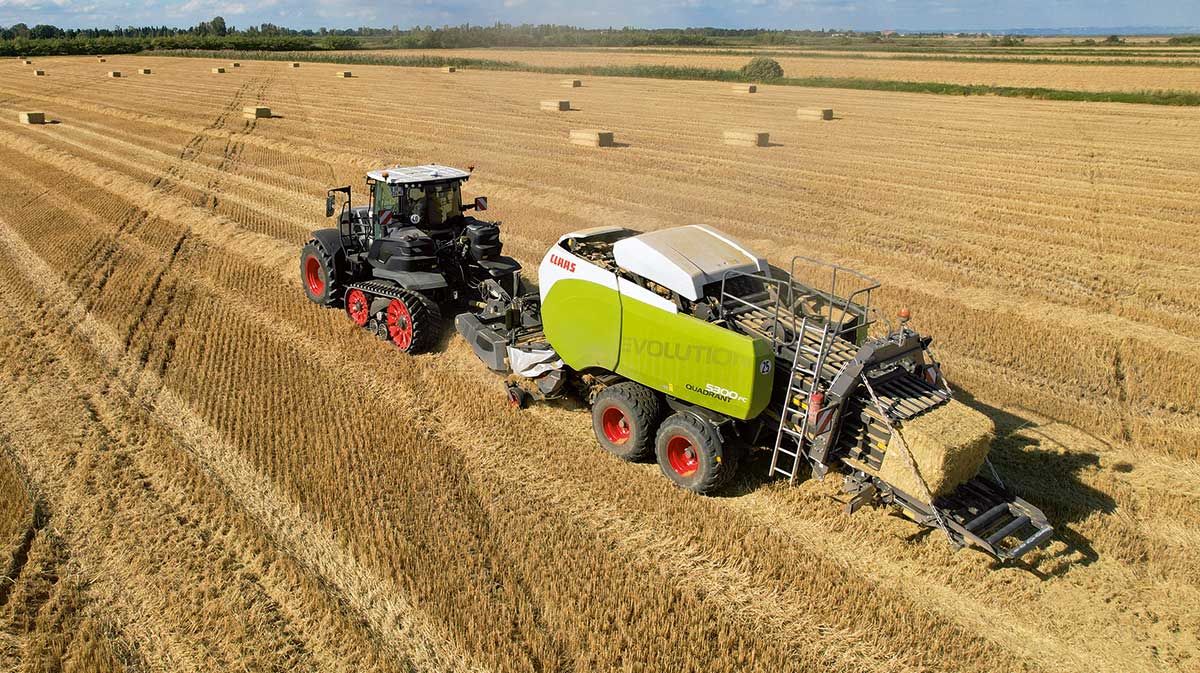
Claas
The most recent updates on the Quadrant Evolution 4200, 5200 and 5300 include a new design of flywheel, along with the option of a hydraulic drive to the pick-up and Power Feeding System (PFS).
To cushion load peaks, especially when baling irregular swaths, and thus protect the power train of the baler and tractor, the mass of the flywheel on the 5200 and 5300 has been increased.
Due to the new design, the inertia of the flywheel has been increased by 46% on the 5200 and 44% on the 5300.
To effectively protect the drive against overload in extreme situations, a slip clutch can be ordered as an alternative to the standard shear bolt protection.
The HD pick-up on the Quadrant Evolution balers is fitted with cam tracks on both sides, said to guarantee maximum torsional resistance and exceptional robustness.
Wear costs have been reduced by using components from the Jaguar pick-up and by reworking and strengthening bearings, intake panels and other parts.
A new option on the 5200 and 5300 is hydraulic drive for the pickup and PFS.
While the speed of the 5-row pick-up, with 18 double tines on each row, is constant at 135rpm, the speed of the PFS feed roller can be adjusted from 200 to 250rpm depending on the operating conditions.
Another new feature is the hydraulically fully automatic folding pick-up guide wheels. These swing out automatically when the pick-up is lowered and swing in fully automatically when the pick-up is raised.
This means that prior to driving on the road, the driver does not have to manually fold in and lock the guide wheels.
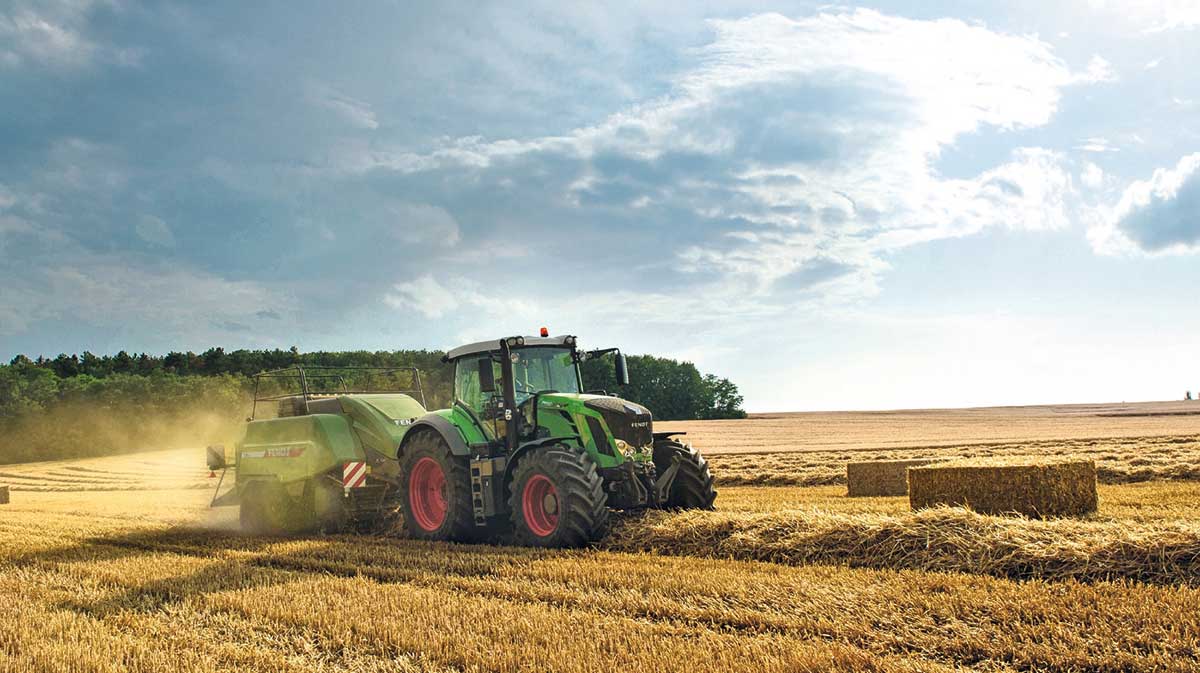
Fendt
The Fendt range received a complete overhaul for the 2023 model year. The company offers 13 different Isobus-compatible models in the standard large square baler range.
All tandem axle models are equipped with a new improved suspension system and passive steering axle as standard.
The design increases manoeuvrability and avoids damage to the ground and turf. In addition, all models will be equipped with larger tyres as standard compared to the previous generation.
A fifth row of tines increases the performance of the pickup. In addition, new plastic pickup bands are now standard to improve the quality of the bales and prevent the entry of contaminants into the baler.
The packer crankshaft bearings are now factory lubricated for life as standard. This reduces daily maintenance and increases service life.
To further improve the longevity of the balers, the bale chamber and the pre-compression chamber have also been revised.
The spring tension of the sensor flap in the pre-compression chamber can now be quickly and easily adjusted to the conditions by means of a lever .
The electronics of the square balers have been comprehensively revised. This is accompanied by an update for the Bale Create user interface.
In addition, all models measure the bale length precisely as standard. The intelligent electronic control monitors the bale length to ensure that they do not exceed the preset length.
Optional twine monitor records the amount of twine used and provides a warning when the twine spool is running low. For the XD models, twine monitoring is a standard feature.
The new electronics also enable the use of the Fendt Connect telemetry system and baling can be controlled through the use of TIM (Tractor Implement Management) which is incorporated into the baler.
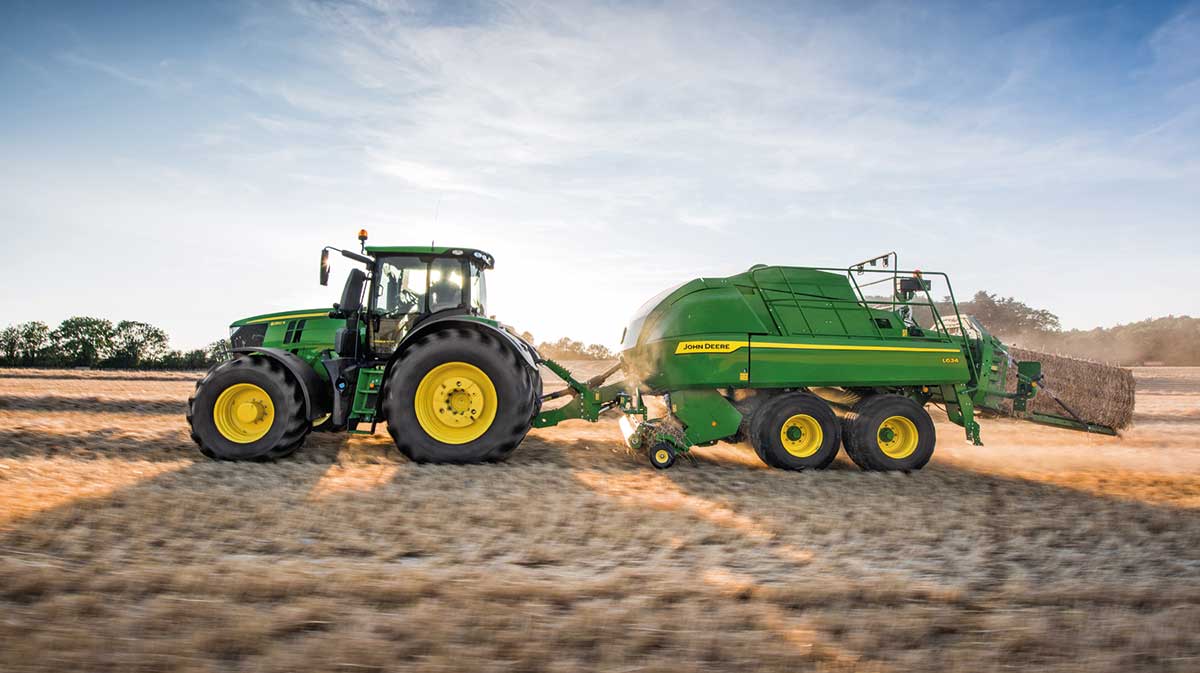
John Deere
The L600 series from John Deere features three models, offering 120×70, 80×90 and 120×90 bales depending on the specification.
At the front, the feeding system matches the wide pickup with cam track technology and high-capacity rotors to provide consistent feed into the pre-compression chamber, with a single feeder fork performing the transfer.
As the chamber fills, pressure is exerted on the wedges to trigger the fork to push material into the main chamber, which are then shaped and compressed via the main plunger.
Updates to the system include a new, uprated flywheel, which is combined with a simplified gearbox setup to minimise power losses.
When the bale is completed, the double knotter system ties off the bale.
John Deere isolates the knotter frame from the rest of the machine, avoiding unnecessary tension and enabling the unit to maintain a consistent level of force on the needles.
To keep the knotting area clean, integrated blowers provide an airflow of 200kph throughout, blowing out chaff to minimise maintenance.
The options list includes a pre-chopper, offering a theoretical chop length of 1.9cm with 48 mounted knives working against two banks of counter knives.
Notably, the system can be lifted completely out of work, providing a ground clearance at the drawbar of 65cm.
For increased operator comfort, John Deere also offers Ride Control, which links to a John Deere tractor with the AutoPowr transmission to compensate for the rocking motion.
According to the company, the system is self-learning, enabling to proactively work in various situations to limit cabin pitching by up to 14%.
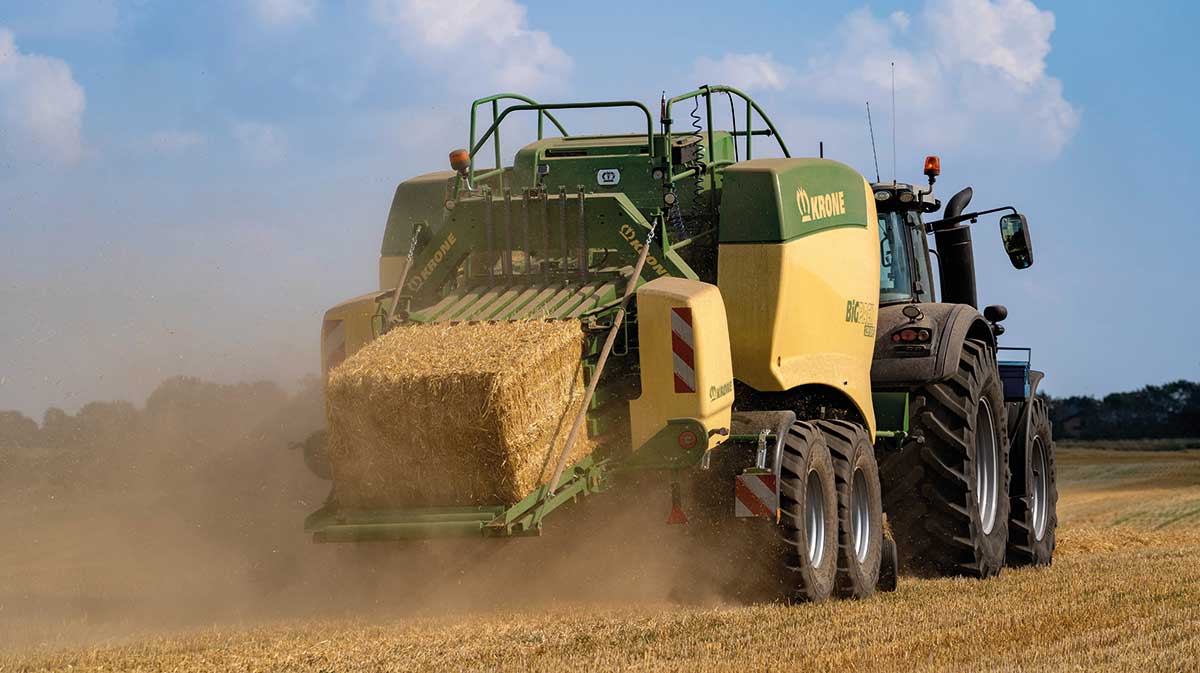
Krone
Last year marked 30 years of the BigPack large square baler, and Krone offers a comprehensive range of 10 machines to suit different operator requirements, with bale sizes from 80×90 up to 120×130, various chopping systems and high density units available.
Two generations of machine are currently on the market. The Gen 4 models include Active Pick-up, comprising actively driven feed rollers to maximise throughputs, as well as the variable filling system (VFS) which adjusts the fill of the main chamber in real time for the most consistent, stable bales possible.
A choice of the VariCut 26, VariCut 51 or the PreChop cutting systems are available, and bale length and force control can be adjusted from the cabin.
Gen 5 machines come equipped with a longer 3.6m chamber, as well as a piece bale ejection system and foldable tailgate.
A hydraulically driven PowerClean fan is part of the standard specification, pressurising the knotter system to blow out dust and chaff to minimise wear and prevent deposits of material.
The knotting system has been further refined to minimise twine waste ending up in the bale.
The V-knotter uses an extractor mounted on the blade lever, which works with the billhook to pull twine through the final knot to stop offcuts.
The VFS system has been redesigned to include an electronic brake. More functions have been integrated into the Isobus system to provide greater control from the cabin, and the optional moisture meter has been repositioned for more accurate readings.
Krone has also expanded its digital services with the SmartBale app, which won awards at Lamma, the Royal Welsh and Royal Highland Shows.
Linked to the baler’s telematics system, the app shows the location and moisture of all bales in the field, significantly easing the collection process.
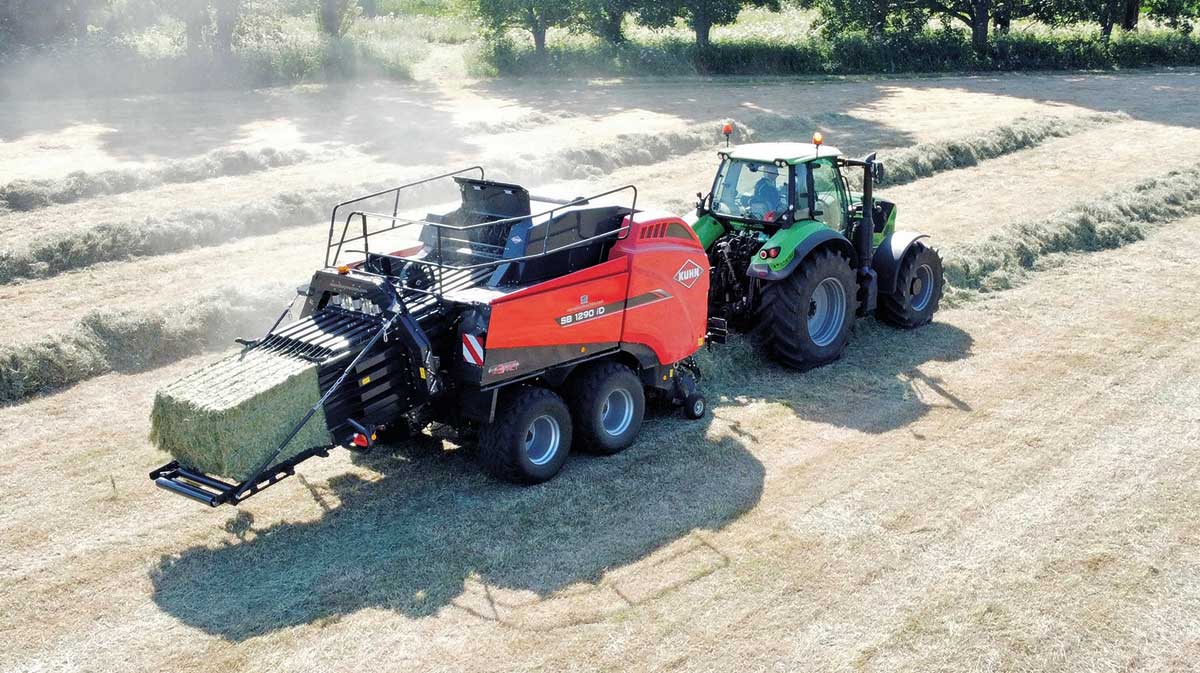
Kuhn Farm Machinery
Kuhn’s flagship SB 1290 iD large square baler has now been available with the company’s TwinPact twin plunger design for over ten years.
The system reportedly allows operators to produce high density, uniformed bales, without increasing the load or strain.
The TwinPact design splits the plunger into upper and lower sections connected via a triangle rod.
The two sections compact the bale in series during a complete plunger cycle, with greater force applied per surface area, while avoiding peak loads on the machine.
The result is 25% higher bale densities in dry crops when compared with conventional plunger designs.
Users of large square balers will be familiar with the constant ‘nodding’ effect from heavy plungers compacting bales.
However, due to the two halves on the plunger running in series, Kuhn states that the system not only reduces this motion, and therefore the stress on machine and user, but it also has a significantly lower power requirement.
The lower power demand has greater benefits for users as there isn’t a need for a high horsepower tractor to power the baler, or for an increased capacity driveline, with oversized flywheel and main frame.
According to the company, it is clear for users to see how the TwinPact design can offer significant advantages to machine longevity, bale density and operator comfort.
Reducing the stress on machinery during long hours at grass and cereal harvest is key to ensure farmers and contractors experience a strong return on their investment.
The system is available on KUHN’s largest square baler – the SB 1290 iD – producing 120×90 bales.
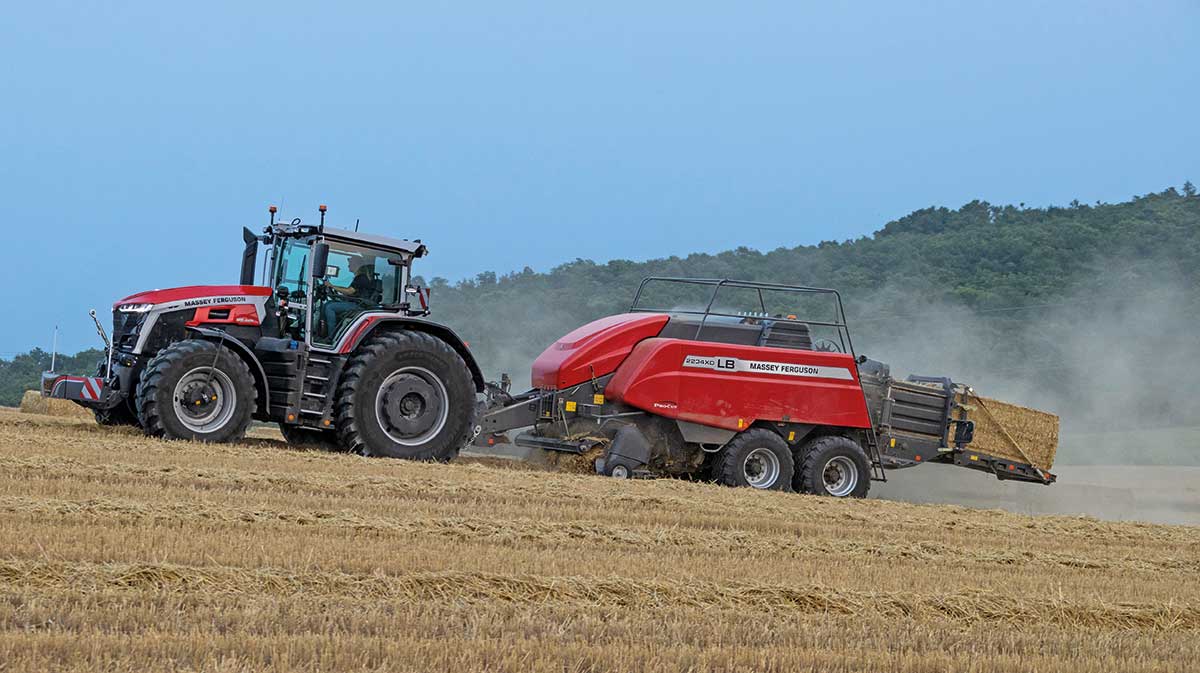
Massey Ferguson
Massey Ferguson’s LB 2200 range covers five models with four bale sizes depending on user requirements. The MF LB 2233 is the smallest model producing 80×90 bales, while the MF LB 2224 offers 120×70 bales.
The MF LB 2234 and MF LB 2234 XD both produce 120×90 bales, while the largest MF LB 2244, offers users a 120×130 bale.
All five models feature a 2.25m pickup width as standard, with a new five-tine bar and streamlined wrapper to increase performance and ground speed.
The MF 2234 XD is designed to produce denser bales than the standard machines, with up to 20% extra material in each bale.
This helps to reduce the number of bales created from a field to ease storage and logistic requirements.
All balers are ISOBUS compatible and there is an option of different ProCut knife banks, from 17 knives on the MF LB 2233, and up to 26 on MF LB 2234 models.
To produce a consistent flake, the MF LB range has a pre-compression chamber that only releases a flake to the chamber when it is fully formed. The heavy-duty plunger is powered by a high strength gearbox connected by two rods.
Load cells within the connecting rods measure the load on the plunger’s face for automatic density control. Double acting density rams apply pressure to both the side and top of the chamber for consistent density.
Integrated bale weighing, a rear camera and hydraulic stand are all options, while tractor implement management (TIM) compatibility and MF Connect are standard on the MF LB range.
TIM allows the baler to automatically adjust the forward speed according to the material feed and crop density.
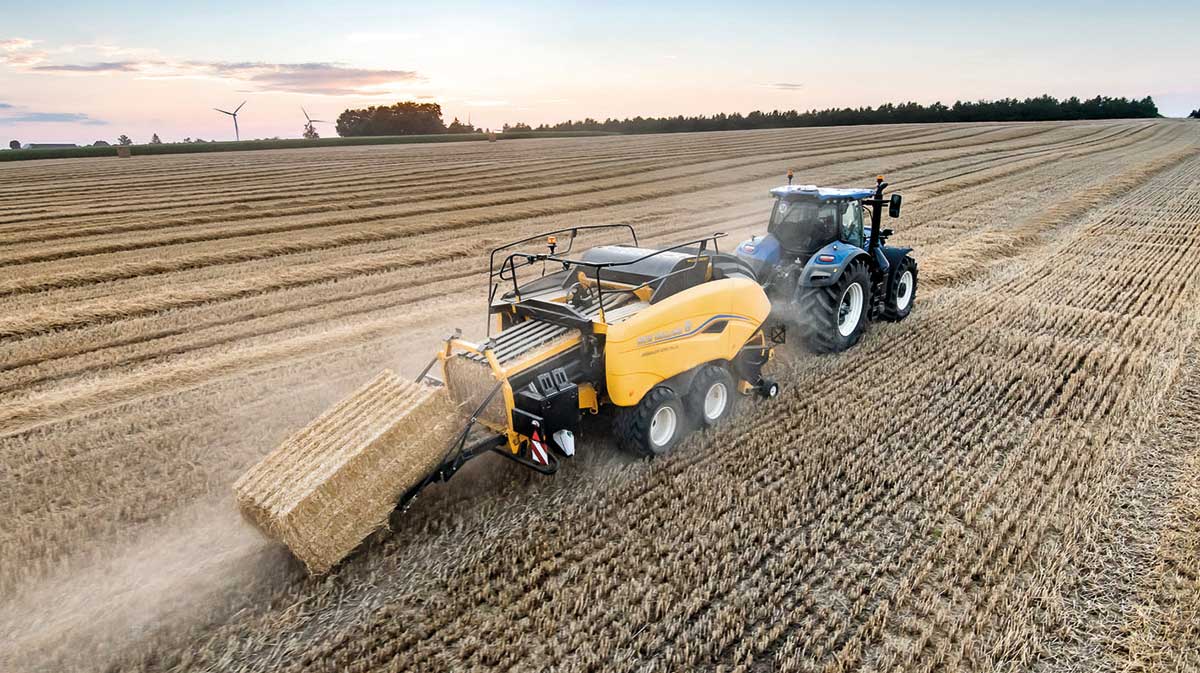
New Holland
The Big Baler range from New Holland has received a series of updates for 2025, starting with its IntelliSense Lidar function, which uses a sensor to monitor the swath density and adjust the tractor’s steering and forward speed to maintain a consistent federate.
This can be linked to the Large Square Baler mode on new T7 HD tractors, which adjusts the engine speed and suspension on the tractor to limit the nodding effect caused during baling.
Various components have been uprated throughout the new machines, including a new dogbone within the packer and more durable bearings.
The knotting system has also been upgraded, and can be specified with more intensive cleaning, including either two or three additional fans depending on the model and compressed air options to blow off the system after use.
On 1270 and 1290 machines, load sensing hydraulics with a flat face coupling option is available. When this is equipped, the baler is automatically provided with a camera (with the option of an in-cab terminal) to monitor the automated processes.
In more difficult conditions, an abrasive pack is available as an option with hard faced packer teeth and stub augers.
The packer bearings can also be specified with auto greasing, available on both wide and narrow units. Completing the unit is a heavy-duty PTO system and the optional larger diameter pickup wheel.
Two variants of the New Holland Big Baler available, the Plus model and the High Density version, with the latter reportedly offering up to 15% increased density when compared to the Plus range.


